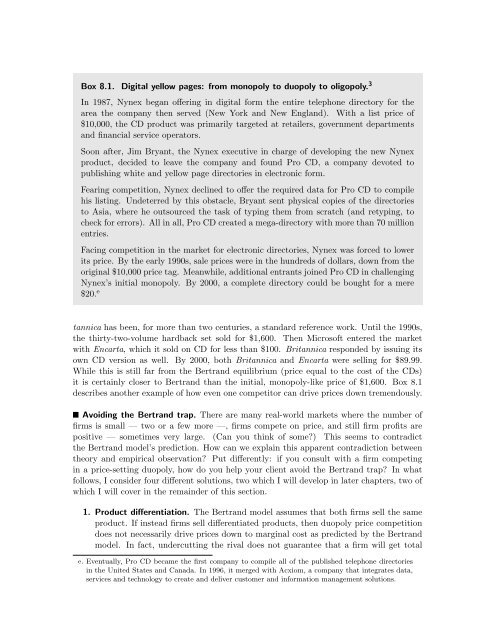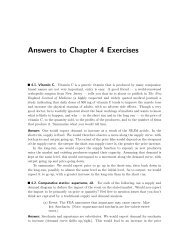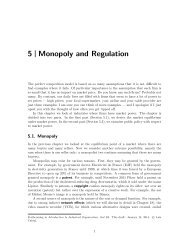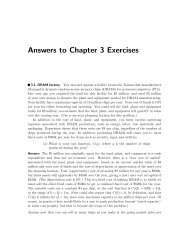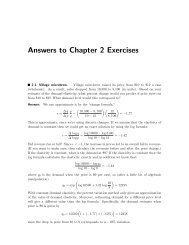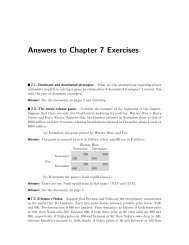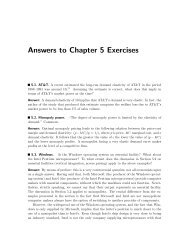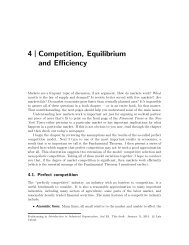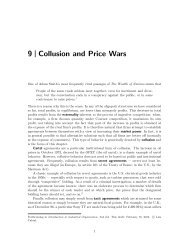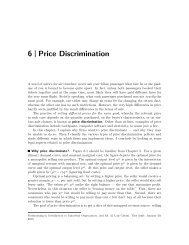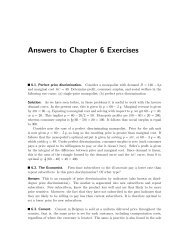8 Oligopoly - Luiscabral.net
8 Oligopoly - Luiscabral.net
8 Oligopoly - Luiscabral.net
You also want an ePaper? Increase the reach of your titles
YUMPU automatically turns print PDFs into web optimized ePapers that Google loves.
Box 8.1. Digital yellow pages: from monopoly to duopoly to oligopoly. 3<br />
In 1987, Nynex began offering in digital form the entire telephone directory for the<br />
area the company then served (New York and New England). With a list price of<br />
$10,000, the CD product was primarily targeted at retailers, government departments<br />
and financial service operators.<br />
Soon after, Jim Bryant, the Nynex executive in charge of developing the new Nynex<br />
product, decided to leave the company and found Pro CD, a company devoted to<br />
publishing white and yellow page directories in electronic form.<br />
Fearing competition, Nynex declined to offer the required data for Pro CD to compile<br />
his listing. Undeterred by this obstacle, Bryant sent physical copies of the directories<br />
to Asia, where he outsourced the task of typing them from scratch (and retyping, to<br />
check for errors). All in all, Pro CD created a mega-directory with more than 70 million<br />
entries.<br />
Facing competition in the market for electronic directories, Nynex was forced to lower<br />
its price. By the early 1990s, sale prices were in the hundreds of dollars, down from the<br />
original $10,000 price tag. Meanwhile, additional entrants joined Pro CD in challenging<br />
Nynex’s initial monopoly. By 2000, a complete directory could be bought for a mere<br />
$20. e<br />
tannica has been, for more than two centuries, a standard reference work. Until the 1990s,<br />
the thirty-two-volume hardback set sold for $1,600. Then Microsoft entered the market<br />
with Encarta, which it sold on CD for less than $100. Britannica responded by issuing its<br />
own CD version as well. By 2000, both Britannica and Encarta were selling for $89.99.<br />
While this is still far from the Bertrand equilibrium (price equal to the cost of the CDs)<br />
it is certainly closer to Bertrand than the initial, monopoly-like price of $1,600. Box 8.1<br />
describes another example of how even one competitor can drive prices down tremendously.<br />
Avoiding the Bertrand trap. There are many real-world markets where the number of<br />
firms is small — two or a few more —, firms compete on price, and still firm profits are<br />
positive — sometimes very large. (Can you think of some?) This seems to contradict<br />
the Bertrand model’s prediction. How can we explain this apparent contradiction between<br />
theory and empirical observation? Put differently: if you consult with a firm competing<br />
in a price-setting duopoly, how do you help your client avoid the Bertrand trap? In what<br />
follows, I consider four different solutions, two which I will develop in later chapters, two of<br />
which I will cover in the remainder of this section.<br />
1. Product differentiation. The Bertrand model assumes that both firms sell the same<br />
product. If instead firms sell differentiated products, then duopoly price competition<br />
does not necessarily drive prices down to marginal cost as predicted by the Bertrand<br />
model. In fact, undercutting the rival does not guarantee that a firm will get total<br />
e. Eventually, Pro CD became the first company to compile all of the published telephone directories<br />
in the United States and Canada. In 1996, it merged with Acxiom, a company that integrates data,<br />
services and technology to create and deliver customer and information management solutions.


